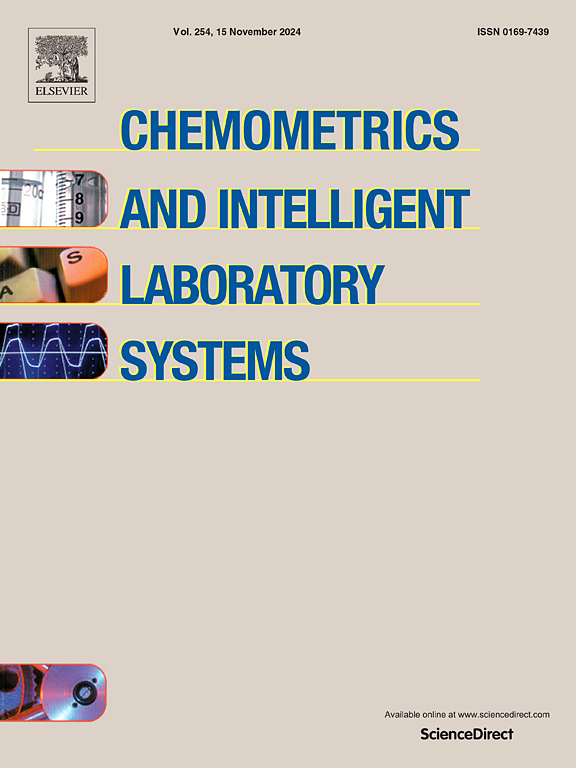Leveraging PLS and Lasso in MARS for high-dimensional FTIR data: A hybrid proposed model for antidiabetic activity of schiff base compounds
IF 3.8
2区 化学
Q2 AUTOMATION & CONTROL SYSTEMS
Chemometrics and Intelligent Laboratory Systems
Pub Date : 2025-05-16
DOI:10.1016/j.chemolab.2025.105418
引用次数: 0
Abstract
In this study, we utilized Fourier Transform Infrared (FTIR) spectral data to create and analyze multiple regression models to predict the anti-diabetic potential of synthesized Schiff bases. Schiff bases are a wide range of compounds characterized by a double bond between the nitrogen and carbon atoms. Their versatility stems from various strategies by which these can be coupled with multiple alkyl or aryl substitutes. The models that were examined consisted of MARS, PLS, SPLS, KPLS, MARS-SPLS, MARS-Kernel-PLS, and an innovative method called MARS-PLS-Lasso, which combines the traditional MARS algorithm with partial least squares and Lasso regularization. To assess the efficacy of the proposed method, we used a high-dimensional spectral data set comprising 19 samples and 1627 predictors. To capture nonlinear interactions in the data, MARS-PLS-Lasso improves the conventional MARS approach by creating adaptive basis functions for each predictor. Lasso regularization was used to choose the most pertinent basis functions and make sure that only the most important predictors were kept. Mean Absolute Error (MAE) and Root Mean Square Error (RMSE) were used on train and test datasets to evaluate the prediction performance. The MARS-PLS-Lasso model outperformed the typical MARS (RMSE = 30.48, MAE = 23.46) and PLS (RMSE = 14.00, MAE = 11.90) models by achieving the lowest test RMSE of 13.00 and MAE of 10.55. When we performed simulation study, MARS-PLS-LASSO again performed the best among basis-integrated models in terms of both low and high correlated data, with the lowest RMSE (0.4708) and MAE (0.2812) in case of data with dimensions 20, 50 and RMSE (0.685, 0.4806) and MAE (0.1325, 0.3819) using data with dimensions 20, 5000 respectively. These results show that the best way to model complicated relationships in high-dimensional data is to use MARS-PLS-Lasso to improve predictive accuracy.
利用PLS和Lasso在MARS高维FTIR数据:希夫碱化合物抗糖尿病活性的混合提议模型
在本研究中,我们利用傅里叶变换红外(FTIR)光谱数据建立并分析多元回归模型来预测合成的希夫碱的抗糖尿病潜能。希夫碱是一种广泛的化合物,其特征是氮原子和碳原子之间有一个双键。它们的多功能性源于它们可以与多个烷基或芳基替代品偶联的各种策略。所研究的模型包括MARS、PLS、SPLS、KPLS、MARS-SPLS、MARS- kernel -PLS,以及一种将传统的MARS算法与偏最小二乘法和Lasso正则化相结合的创新方法MARS-PLS-Lasso。为了评估该方法的有效性,我们使用了包含19个样本和1627个预测因子的高维光谱数据集。为了捕获数据中的非线性相互作用,MARS- pls - lasso通过为每个预测器创建自适应基函数来改进传统的MARS方法。Lasso正则化用于选择最相关的基函数,并确保只保留最重要的预测因子。在训练和测试数据集上使用平均绝对误差(MAE)和均方根误差(RMSE)来评估预测性能。MARS-PLS- lasso模型的最低检验RMSE为13.00,MAE为10.55,优于典型的MARS (RMSE = 30.48, MAE = 23.46)和PLS (RMSE = 14.00, MAE = 11.90)模型。当我们进行模拟研究时,MARS-PLS-LASSO在低相关数据和高相关数据方面再次在基础集成模型中表现最好,在维度为20和50的数据中RMSE(0.4708)和MAE(0.2812)最低,在维度为20和5000的数据中RMSE(0.685, 0.4806)和MAE(0.1325, 0.3819)分别最低。这些结果表明,在高维数据中建模复杂关系的最佳方法是使用MARS-PLS-Lasso来提高预测精度。
本文章由计算机程序翻译,如有差异,请以英文原文为准。
求助全文
约1分钟内获得全文
求助全文
来源期刊
CiteScore
7.50
自引率
7.70%
发文量
169
审稿时长
3.4 months
期刊介绍:
Chemometrics and Intelligent Laboratory Systems publishes original research papers, short communications, reviews, tutorials and Original Software Publications reporting on development of novel statistical, mathematical, or computer techniques in Chemistry and related disciplines.
Chemometrics is the chemical discipline that uses mathematical and statistical methods to design or select optimal procedures and experiments, and to provide maximum chemical information by analysing chemical data.
The journal deals with the following topics:
1) Development of new statistical, mathematical and chemometrical methods for Chemistry and related fields (Environmental Chemistry, Biochemistry, Toxicology, System Biology, -Omics, etc.)
2) Novel applications of chemometrics to all branches of Chemistry and related fields (typical domains of interest are: process data analysis, experimental design, data mining, signal processing, supervised modelling, decision making, robust statistics, mixture analysis, multivariate calibration etc.) Routine applications of established chemometrical techniques will not be considered.
3) Development of new software that provides novel tools or truly advances the use of chemometrical methods.
4) Well characterized data sets to test performance for the new methods and software.
The journal complies with International Committee of Medical Journal Editors'' Uniform requirements for manuscripts.

 求助内容:
求助内容: 应助结果提醒方式:
应助结果提醒方式:


